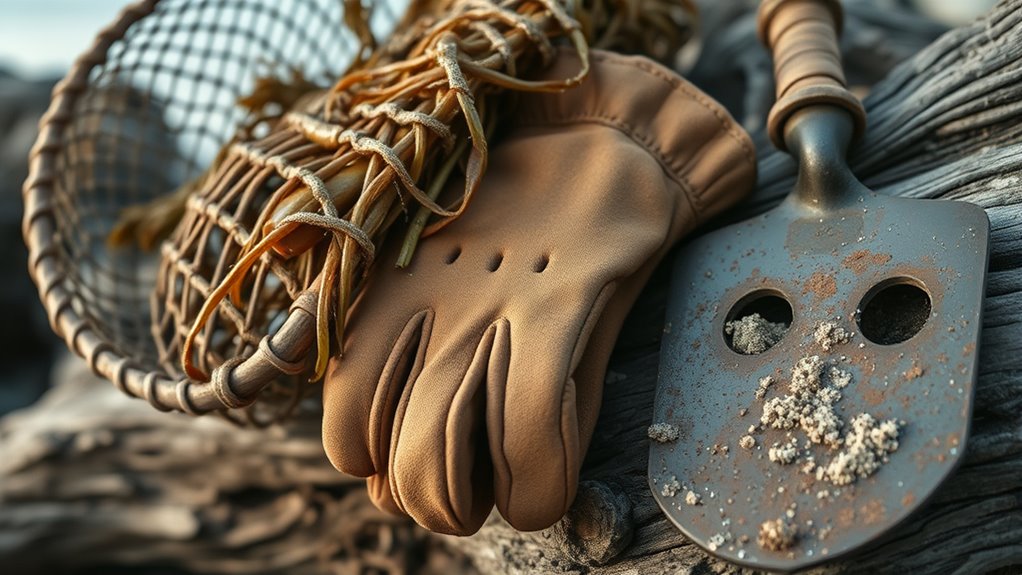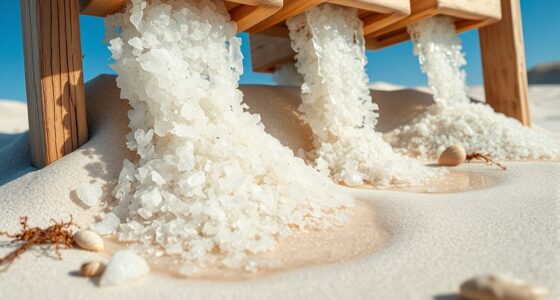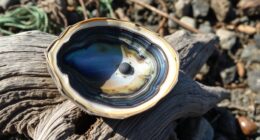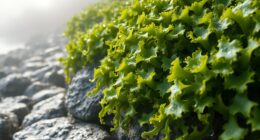To care for your coastal foraging gear, rinse everything with fresh water after each trip to remove salt, sand, and debris. Dry your tools thoroughly, inspect for damage, and repair or sharpen blades as needed. Store your gear in a cool, dry place, using protective cases for delicate items and hanging larger tools to promote airflow. Regular maintenance extends your equipment’s lifespan and keeps it safe and effective—if you continue, you’ll discover tips to optimize your gear further.
Key Takeaways
- Rinse all gear with fresh water after use to remove salt, sand, and debris.
- Store tools in a cool, dry, well-ventilated area, away from direct sunlight and humidity.
- Regularly inspect blades, handles, and moving parts; sharpen, repair, or replace as needed.
- Dry all equipment thoroughly before storage to prevent rust and mold buildup.
- Use protective cases or sheaths for sharp or delicate items to prevent damage and maintain longevity.

Caring for your coastal foraging gear is essential to guarantee it stays effective and lasts season after season. Proper gear cleaning and storage techniques are key to maintaining your equipment’s durability and functionality, ensuring you’re always ready for your next adventure. After each foraging trip, take the time to thoroughly clean your gear. Use fresh water to rinse away salt, sand, and any debris that might cause corrosion or wear. For tools like knives or scrapers, gently scrub with a soft brush or cloth to remove stubborn grime. Avoid harsh chemicals or abrasives that could damage blades or handles. Dry everything completely before storing; moisture left on your gear promotes rust and mold, which can compromise their integrity over time.
When it comes to storage techniques, how you keep your gear can considerably extend its lifespan. Store your tools in a cool, dry place away from direct sunlight, which can weaken materials over time. Consider using protective sheaths or cases for sharp or delicate items—these not only prevent accidental cuts but also shield your gear from dust and environmental elements. For larger equipment like nets or bags, make sure they’re clean and completely dry before folding and storing them. Avoid leaving gear in damp or humid environments, as this encourages corrosion and mold growth. Hanging tools and equipment in a well-ventilated area helps air circulate, reducing the risk of moisture buildup.
To further prolong the life of your gear, inspect it regularly for signs of damage or wear. Check blades for chips or rust, handles for cracks, and any moving parts for smooth operation. Address issues promptly—sharpen blades, replace worn parts, or recondition handles as needed. Applying a light coat of oil to metal tools can also provide an extra layer of protection against moisture. When storing, keep your gear organized so you can find what you need quickly and avoid unnecessary damage from tossing or jamming items together. Using dedicated storage containers or wall hooks can keep everything accessible and well-maintained.
Frequently Asked Questions
How Often Should I Inspect My Foraging Gear for Damage?
You should inspect your foraging gear after each use to catch any damage early. Regular inspections help you identify issues like tears or wear that might require gear replacement. Document damage with photos or notes to track its progression. This routine guarantees your gear stays safe and effective, reducing the risk of accidents. By staying vigilant, you keep your gear in top shape and ready for your next coastal adventure.
Can I Use Household Cleaning Products to Maintain My Gear?
You probably think household cleaning products are safe for your gear, but they’re often packed with household product dangers. Using DIY cleaning solutions might seem convenient, but they can damage your foraging gear’s materials and compromise its integrity. Stick to gentle, gear-specific cleaners to keep your gear in top shape. After all, risking damage for a quick clean isn’t worth it—your gear deserves better than DIY disasters.
What Storage Methods Prolong Gear Lifespan During Off-Season?
To prolong your gear’s lifespan during the off-season, opt for seasonal storage in a cool, dry, and well-ventilated space. Make sure to clean and dry your gear thoroughly before storing, as moisture can cause damage. Use breathable bags or containers to prevent mold and corrosion. Proper seasonal storage helps maintain gear longevity, ensuring it stays in great condition and ready for your next coastal adventure.
Are There Eco-Friendly Cleaning Options for Coastal Gear?
Yes, you can use eco-friendly cleaning options for your coastal gear. Biodegradable detergents are a great choice, as they break down naturally without harming the environment. Natural cleaning solutions like vinegar, baking soda, and lemon juice also work effectively to clean and disinfect gear. These options are gentle yet effective, helping you maintain your gear’s performance while protecting coastal ecosystems. Always rinse thoroughly to remove residues and guarantee longevity.
How Do I Prevent Corrosion on Metal Components?
To prevent corrosion on metal components, you should apply metal treatment products that create a protective barrier. Use corrosion inhibitors regularly, especially after exposure to saltwater, to prevent rust and deterioration. Rinse your gear with fresh water after each use, then dry it thoroughly before storage. Keep metal parts in a cool, dry place, and reapply corrosion inhibitors periodically to maintain ideal protection against corrosion.
Conclusion
Taking care of your coastal foraging gear isn’t just maintenance; it’s an act of respect for the ocean’s gifts. With proper cleaning and storage, your gear stays ready for adventures, like a trusted friend always by your side. Remember, neglect can turn your trusty tools into tired, useless remnants—so treat them well. By caring for your gear, you’re not just preserving equipment, but also safeguarding the magic of your coastal explorations.









